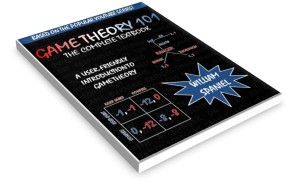Dominance was the very first thing we learned about in game theory. Introducing multiple types gives rise to more complicated types of dominance—ex ante dominance and interim dominance—which we explore in this lecture.
Takeaway Points
- An ex ante dominated strategy is any strategy for a player such that an alternative strategy for that player provides a greater payoff for that player regardless of all other players’ strategies.
- The ex ante perspective comes at the dominance problem as though a person is formulating an optimal strategy before he or she knows their type and then concludes which strategies will be bad later on.
- An interim dominated strategy is a strategy for a type such that an alternative strategy for that type provides a greater payoff for that type regardless of all other players’ strategies.
- The interim perspective comes at the dominance problem from the perspective of a particular type that knows all of its payoffs and then reasons in a manner similar to how we have treated dominance in the past.
- If a strategy is interim dominated, then the corresponding strategies at the player level are ex ante dominated.
- The converse of this statement is not true. A strategy that is ex ante dominated may or may not have any corresponding interim dominance.
- Ex ante dominance can arise without interim dominance when comparing strategies where the types are playing their relatively strong choices versus their relatively weak choices.
- Whenever you see a strictly dominated strategy—be it ex ante or interim—you can safely remove it from consideration. You will not lose any Bayesian Nash equilibria in the process.
- The standard weak dominance caveat applies: whatever Bayesian Nash equilibria you find in the reduced game will still be Bayesian Nash equilibria of the game as a whole, but you may also delete some equilibria.

